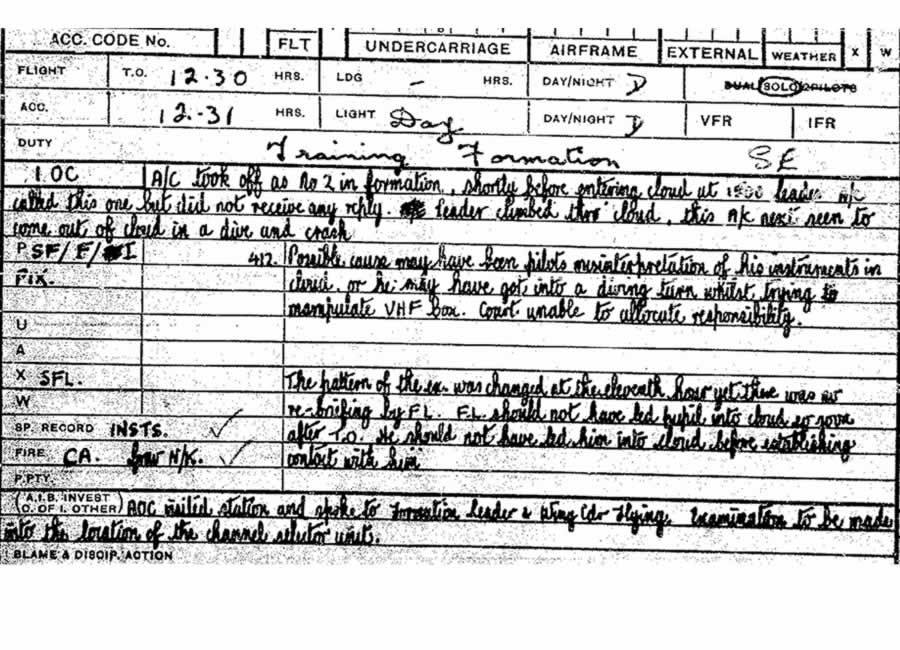
The examination
So far this report, has contained little in the way of speculation on my part. Most of the material presented is by the way of the words of others who were involved, or from written records that have been made available to me. This final section looks at the possible cause of the accident, although in the final analysis only PO. Kidd knew the actual sequence of events that led up to the crash.
On the Friday following the accident, 15th August, Wg. Cdr McClelland arrived at Finningley to attend a court of enquiry into the loss of the aircraft and its pilot.. This officer was from RAF Merryfield in Somerset which was the base of 208 AFS. I assume that he was be chosen because of his senior rank and his lack of day to day contact with the operations of 215 AFS based at Finningley. I do not have a transcript of this court of enquiry, but its main conclusions would have been used when compling the form AM1180.
The RAF produce a form known as AM 1180. This form records details of aircraft
accidents and is often used for statistical purposes. Part of this form is reproduced
below, and it contains some guidance to the events of the mornings flight.
The report suggests that the exercise was changed at the eleventh hour. This may well have been as a result of the changing weather pattern, details of which are given later.
I was fortunate in being able to locate and then speak by telephone to Sq Ldr Liskutin, who seemed to have a remarkably clear recollection of the event and of John Kidd. The impression that I gained was that he along with other instructors also felt themselves to be victims of these accidents and of the training programme that had proved to be so costly in pilot lives. The expanding and rapid training of young men using these powerful aircraft would inevitably lead to accidents.
The two aircraft and their pilots were in radio contact before take off. I
assume that this would be a frequency on channel A, allowing all persons in
the airfield circuit to communicate. Once airborne and clear of the airfield
the two aircraft, which were due to practice formation flying, would switch
to another previously agreed to channel and their communication would be via
that frequency until they came back into the Finningley circuit once more, when
they would revert to channel A. The form 1180 and a later inquest report, indicates
that a successful change of frequency was not made  and
that the lead aircraft entered cloud without establishing clear radio contact
with the following Mk4. I have no clear idea of the density of the cloud that
morning, but the impression gained is that it was unwise to lead an inexperienced
student into cloud, when the student was flying solo. Remember that all of the
other instrument flying had been done in a dual T7, and possibly only simulated
cloud conditions. John Kidds solo Meteor time was just 17 hours at this stage.
My information is that the actual flying solo within heavy cloud was not part
of the AFS course. The accident rate amongst these schools at the time was so
appalling that I would imagine that this activity was considered far too much
of a risk.
and
that the lead aircraft entered cloud without establishing clear radio contact
with the following Mk4. I have no clear idea of the density of the cloud that
morning, but the impression gained is that it was unwise to lead an inexperienced
student into cloud, when the student was flying solo. Remember that all of the
other instrument flying had been done in a dual T7, and possibly only simulated
cloud conditions. John Kidds solo Meteor time was just 17 hours at this stage.
My information is that the actual flying solo within heavy cloud was not part
of the AFS course. The accident rate amongst these schools at the time was so
appalling that I would imagine that this activity was considered far too much
of a risk.
It is possible that the cloud was more intense in this particular spot than
had been anticipated and John Kidd expecting to be able to formate upon his
leader suddenly found that he was unable to do so. He may momentarily, have
been distracted toward the radio and away from his cockpit instruments. The
disorientation experienced by him could have been quite severe and something
that he had not experienced before. The natural tendency to avoid the risk of
collision with his leader, somewhere ahead and above, may also have led to the
slight application of an opposite bank and this coupled with any distraction
away from the instruments may have quickly developed into a diving turn. He
was possibly still disorientated as he came out of cloud at high speed, perhaps
as high as 360 mph possibly still unable obtain a clear visual horizon and his
inexperience with instrument flying left little time for corrective action.
My estimation of the flight time from Firbeck Hall to the impact site 1.8km
away is just ten seconds. It seems that even an experienced Meteor pilot would
have been hard pressed to recover from this situation. Judging by the witness
reports and the impact angle my guess is that he only just failed to recover
control. 
Shown left is an extract taken from the Doncaster Chronicle published after the inquest into the pilots death. The evidence given, closely matches that related to me 50 years later. As an outside observer, it does seem that the entry into cloud at this stage of his training was premature. I examined a copy of the pilot's log book, which had been made available to me and this showed instrument flying exercises were conducted on the Wednesday, Thursday and Friday before his week of leave. These exercises were carried out in a two seat T7 with Fl Lt Liskutin acting as instuctor. In the report shown opposite, he has used the phrase "I considered him fully proficient on normal handling which included instrument flying".
I suspect that it was his lack of experience of flying on instruments that was the major contributing cause of the accident. I feel that if instructor and student had been in the same aircraft, this accident would have been avoided. The warning issued by his instructor at 8 AFS on the 29th May had now been fatally justified.
John Kidds death was yet another one in the Meteor training programme that claimed so many lives during the early 1950's. He had served just 227 days.
In March 2003, I was able to visit the Public Records Office at Kew, and the operational record book for 215 AFS, was made available for me to study, its secrecy having been withdrawn in 1987. It records many mundane events and statistics, but the brief indication of the days weather and the number of hours flown together with sorties mounted was interesting. The Monday of the accident was described as cloudy with rain mid day and early evening. The previous two days were described as cloudy with showers in the day plus drizzle, but because these were the weekend no flying took place. On the Monday the total flying time for the airfield was 40hr 40mins, with 67 sorties. The next day Tuesday shows 70hrs 15 mins, with 101 sorties. It may be assumed that the weather conditions on the Monday were not perfect. This written record contrasts with the memory of surviving eye witnesses, who described the weather as, a lovely summers day.
The whole of August appears to have had indifferent weather, which effected the flying training programme. The total hours flown is shown as 1101 and the sorties launched 1612. This is below that for June and July which shows figures of 1294 hrs plus 1820 sorties and 1487 hrs plus 2143 sorties.
The record book does give a production line feel to its statistics and its production of trained pilots.
The number of courses being operated in August 1952 was eight. These were numbered from 6 through to 13 and John Kidd was a member of 8 course. This course was scheduled to run from 03/06/52 until 05/09/52. Each course had about 9 student pilots assigned to it.
A further indication of the underlying accident rate is shown by the state of 215 's courses at the end of August. This shows 8 course having 1 killed 11/08/52, 9 course 1 killed 24/07/52 and 10 course 1 killed 22/07/52.
215 AFS closed in 1954 by which time its final course number was 43. Finningley airfield was then extended pending the arrival of Vulcan aircraft, when it continued in its training role.